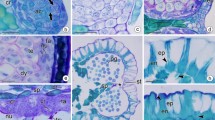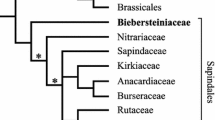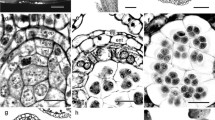Abstract
Two representative genera of Hernandiaceae,Gyrocarpus andHernandia, were investigated embryologically to contribute to a better understanding of their respective evolutionary position. Comparisons with other lauralean families using Chloranthaceae or Annonaceae (as a representative of Magnoliales) as an outgroup of Laurales (if present, plus other related taxa) support a lauraceous affinity for the two genera because of the presence of ramified raphal vascular bundles at the chalaza (a synapomorphy), but do not provide evidence for the separation of Hernandiaceae from Lauraceae.Hernandia rather shares with Lauraceae two apomorphies (i.e., the seed pachychalazy and the ruminate seed) which may be homoplasies judged from results of cladistic and molecular studies published elsewhere.Hernandia is greatly divergent from an ancestral line common withGyrocarpus and is even diversified within the genus. Based on evidence from embryology as well as from other sources, it seems best to accept two separate subfamilies in Hernandiaceae as usually have been accepted: one is a derived subfamily Hernandioideae, and the other a less specialized Gyrocarpoideae.
Similar content being viewed by others
References
Bambacioni-Mezzetti, V. 1935. Ricerche morfologiche sulle Lauracee, Lo sviluppo dell'ovulo e dei sacchi pollinici nelLaurus nobilis L. Ann. Bot. (Roma)21: 186–204.
Bambacioni-Mezzetti, V. 1941. Ricerche morfologiche sulle Lauracee, Embriologia dellaUmbellularia californica Nutt. e delLaurus canariensis Webb. Ann. Bot. (Roma)22: 99–119.
Bhandari, N.N. 1971. Embryology of the magnoliales and comments on their relationships. J. Arnold Arbor.52: 1–39, 285–304.
Chase, M.W., Soltis, D.E., Olmstead, R.G., Morgan, D., Les, D.H., Mishler, B.D., Duvall, M.R., Price, R.A., Hills, H.G., Qiu, Y-L., Kron, K.A., Rettig, J.H., Conti, E., Palmer, J.D., Manhart, J.R., Sytsma, K.J., Michaels, H.J., Kress, W.J., Karol, K.G., Clark, W.D., Hedren, M., Gaut, B.S., Jansen, R.K., Kim, K.-J., Wimpee, C.F., Smith, J.F., Furnier, G.R., Strauss, S.H., Xiang, Q.-Y., Plunkett, G.M., Soltis, P.S., Swensen, S.M., Williams, S.E., Gadek, P.A., Quinn, C.J., Eguiarte, L.E., Golenberg, E., Learn, G.H., Graham, Jr. S.W., Barrett, S.C.H., Dayanandan, S. andAlbert, V.A. 1993. Phylogenetics of seed plants: an analysis of nucleotide sequences from the plastid generbcL. Ann. Missouri Bot. Gard.80: 528–580.
Choudhury, J.K. andMitra, J.N. 1953. Abnormal tricotyledonous embryo and the morphological structure of normal fruit and seed ofCinnamomum camphora F. Nees. Sci. & Cult.19: 159.
Christmann, M. 1986. Beiträge zur Histologie der Annonaceen-Samen. Bot. Jahrb. Syst.106: 379–390.
Corner, E.J.H. 1949. The annonaceous seed and its four integuments. New Phytol.48: 332–364.
Corner, E.J.H. 1976. The Seeds of Dicotyledons, vols. 1, 2. Cambridge Univ. Press, Cambridge.
Coy, G. V. 1928. Morphology ofSassafras in relation to phylogeny of angiosperms. Bot. Gaz.86: 149–172.
Cronquist, A. 1981. An Integrated System of Classification of Flowering Plants. Columbia Univ. Press, New York.
Cronquist, A. 1988. The Evolution and Classification of Flowering Plants, 2nd ed., The New York Botanical Garden, New York.
Dahlgren, G. 1989. The last Dahlgrenogram. System of classification of the dicotyledons.In Kit Tanet al., eds., Plant Taxonomy, Phytogeography and Related Subjects. pp. 249–260. Edinburgh Univ. Press, Edinburgh.
Davis, G.L. 1966. Systematic Embryology of the Angiosperms. John Wiley & Sons, New York.
Dutt, B.S.M. 1978. Embryogeny inGyrocarpus americanus Jacq. Curr. Sci.47: 636.
Dutt, B.S.M. 1979. Fruit and seed ofGyrocarpus americanus Jacq. Curr. Sci.48: 594–596.
Edwards, J.G. 1920. Flower and seed ofHedyosmum nutans. Bot. Gaz.70: 409–424.
Endress, P.K. 1972. Zur vergleichenden entwicklungsmorphologie, embryologie und systematik bei Laurales. Bot. Jahrb. Syst.92: 331–428.
Endress, P.K. 1980. Floral structure and relationships ofHortonia (Monimiaceae). Pl. Syst. Evol.133: 199–221.
Endress, P.K. 1987. The Chloranthaceae: reproductive structures and phylogenetic position. Bot. Jahrb. Syst.109: 153–226.
Endress, P.K. andHufford, L.D. 1989. The diversity of stamen structures and dehiscence patterns among Magnoliidae. Bot. J. Linn. Soc.100: 45–85.
Endress, P.K. andSampson, F.B. 1983. Floral structure and relationships of the Trimeniaceae (Laurales). J. Arnold Arbor.64: 447–473.
Gardner, R.O. 1974. Trinucleate pollen inBeilschmiedia Nees (Lauraceae). New Zealand J. Bot.12: 243–244.
Hellborn, O. 1931. Studies on the taxonomy, geographical distribution and embryology of the genusSiparuna Aubl. Svensk Bot. Tidskr.25: 202–228.
Herms, W.B. 1907. Contributions to the life history ofAsimina triloba. Ohio Naturalist8: 211–216.
Hyland, B.P.M. 1989. A revision of Lauraceae in Australia (excludingCassytha). Austral. Syst. Bot.2: 135–367.
Johansen, D.A. 1950. Plant Embryology. Chronica Botanica Co., Massachusetts.
Juliano, J.B. 1935. Morphological contributions to the genusAnnona L. Philipp. Agric.24: 528–541.
Kasapligil, B. 1951. Morphological and ontogenetic studies ofUmbellularia californica Nutt. andLaurus nobilis L. Univ. Calif. Publ. Bot.25: 115–240.
Kubitzki, K. 1969. Monographie der Hernandiaceen. Bot. Jahrb. Syst.89: 78–209.
Kubitzki, K. 1970.Biasolettia nymphaeaefolia Prest eine Hernandiacee. Bot. Jahrb. Syst.90: 272.
Kubitzki, K. 1993. Hernandiaceae.In Kubitzkiet al., eds., The Families and Genera of Vascular Plants. vol 2. Flowering Plants-Dicotyledons. pp. 334–338. Springer-Verlag, Berlin.
Lampton, R.K. 1957. Floral morphology inAsimina triloba. I. Development of ovule and embryo sac. Bull. Torrey Bot. Club84: 151–156.
Loconte, H. andStevenson, D.W. 1991. Cladistics of the Magnoliidae. Cladistics7: 267–296.
Mathur, S.L. 1968. Development of the male and female gametophytes ofCalycanthus fertilis Walt. Proc. Natl. Inst. Sci. India, B.34: 323–329.
Mauritzon, J. 1935. Zur embryologie vonPeumus boldus. Arch. Bot. (Forli)11: 317–327.
Pal, S. 1975. Embryo development inCinnamomum cecidodaphne Meissn. Bangladesh J. Bot.4: 181–182.
Parulekar, N.K. 1970. Annonaceae. Proceedings of a symposium on comparative embryology of angiosperms. Bull. Indian Natl. Sci. Acad.41: 38–41.
Pellegrini, O. 1955. Particolare formazione austoriale di natura endospermica e comportamento delle antipode inLaurus nobilis L. Delpinoa8: 155–161.
Periasamy, K. 1962. The ruminate endosperm: development and type of rumination.In P. Maheshwari, ed., Plant Embryology-A Symposium, pp. 62–74. Council of Scientific and Industrial Research, New Delhi.
Periasamy, K. andSwamy, B.G.L. 1961. Studies in the Annonaceae. 2. The development of ovule and seed inCananga odorata andMiliusa wightiana. J. Indian Bot. Soc.40: 206–216.
Periasamy, K. andThangavel, S. 1988. Anther development inXylopia nigricans. Proc. Indian Acad. Sci., Pl. Sci.98: 251–255.
Peter, J. 1920. Zur entwicklungsgeschichte einiger Calycanthaceen. Beitr. Biol. Pflanzen14: 59–84.
Qiu, Y.-L., Chase, M.W., Les, D.H. andParks, C.R. 1993. Molecular phylogenetics of the Magnoliidae: Cladistic analyses of nucleotide sequences of the plastid generbcL. Ann. Missouri Bot. Gard.80: 587–606.
Rao, P.R.M. 1979. Seed and fruit anatomy ofCassytha filiformis L. with comments on its systematic position. Israel J. Bot.28: 44–50.
Rao, P.R.M. 1986. Seed and fruit anatomy inGyrocarpus americanus with a discussion on the affinities of Hernandiaceae. Israel J. Bot.35: 133–152.
Sampson, F.B. 1969a. Studies on the Monimiaceae. I. Floral morphology and gametophyte development of Hedycarya arborea J.R. et G. Forst. (subfamily Monimioideae). Austral. J. Bot.17: 403–424.
Sampson, F.B. 1969b. Studies on the Monimiaceae. III. Gametophyte development ofLaurelia novae-zelandiae A. Cunn. (subfamily Atherospermoideae). Austral. J. Bot.17: 425–439.
Samuelsson, G. 1914. Über die pollenentwicklung vonAnnona undAristolochia und ihre systematische bedeutung. Svensk Bot. Tidskr.8: 181–189.
Sastri, R.L.N. 1956. Embryo sac haustoria inCassytha filiformis. Curr. Sci.25: 401–402.
Sastri, R.L.N. 1957. Floral morphology and embryology of some Ranales. Unpub. D. Sc. Thesis, Andhra Univ.
Sastri, R.L.N. 1958. Studies in Lauraceae. II. Embryology ofCinnamomum andLitsea. J. Indian Bot. Soc.37: 266–278.
Sastri, R.L.N. 1962. Studies in the Lauraceae. III. Embryology ofCassytha. Bot. Gaz.123: 197–206.
Sastri, R.L.N. 1963. Studies in the Lauraceae. IV. Comparative embryology and phylogeny. Ann. Bot. n.s.27: 425–433.
Schmid, R. 1986. On Cornerian and other terminology of angiospermous and gymnospermous seed coats: historical perspective and terminological recommendations. Taxon35: 476–491.
Schnart, K. 1931. Vergleichende Embryologie der Angiospermen. Bornträger, Berlin.
Schroeder, C.A. 1952. Floral development, sporogenesis, and embryology in the avocado,Persea americana. Bot. Gaz.113: 270–278.
Sedgley, M. 1979. Light microscope study of pollen tube growth, fertilization and early embryo and endosperm development in the avocado varieties Fuerte and Hass. Ann. Bot.44: 353–359.
Shutts, C.F. 1960. Wood anatomy of Hernandiaceae and Gyrocarpaceae. Trop. Woods113: 85–123.
Soueges, R., Guignard, J.L. andMestre, J.C. 1967. Développement de l'embryon chez leLaurus nobilis L. (Lauracées). Phytomorphology17: 255–261.
Subramanyam, K. 1962. Embryology in relation to systematic botany with particular reference to the Crassulaceae.In P. Maheshwari, ed., Plant Embryology-A symposium, pp 94–112. Council of Scientific and Industrial Research, New Delhi.
Takhtajan, A.L. 1987. Systema Magnoliophytorum. Nauka, Leningrad. (In Russian).
Thorne, R.F. 1983. Proposed new realignments in the angiosperms. Nordic J. Bot.3: 85–117.
Thorne, R.F. 1992. Classification and geography of the flowering plants. Bot. Rev.58: 225–348.
Tobe, H. 1989. The embryology of angiosperms: its broad application to the systematic and evolutionary study. Bot. Mag. Tokyo102: 351–367.
Tomer, E. andGottreich, M. 1975. Observations on the fertilization process in avocado with fluorescent light. Euphytica24: 531–535.
Van Heel, W.A. 1971. The labyrinthic seed ofHernandia peltata Meissn. in DC. Proc. Kon. Ned. Akad. Wetensch. C.74: 46–51.
Vijayaraghavan, M.R. 1964. Morphology and embryology of a vesselless dicotyledon,Sarcandra irvingbaileyi Swamy, and systematic position of the Chloranthaceae. Phytomorphology14: 429–441.
Walker, J.W. 1976. Evolutionary significance of the exine in the pollen of primitive angiosperms.In I.K. Ferguson and J. Muller, eds., The Evolutionary Significance of the Exine. pp. 251–308. Academic Press, London.
Yakovlev, M.S. 1981. Comparative Embryology of Flowering Plants, vol. 1. Winteraceae-Juglandaceae. Nauka, Leningrad. (In Russian).
Yoshida, O. 1957. Embryologische studien über die ordnung Piperales. I. Embryologie vonChloranthus japonicus. J. Coll. Arts Chiba Univ.2: 172–178.
Yoshida, O. 1959. Embryologische studien über die ordnung Piperales. II. Embryologie vonChloranthus serratus. J. Coll. Arts Chiba Univ.2: 295–303.
Author information
Authors and Affiliations
Rights and permissions
About this article
Cite this article
Heo, K., Tobe, H. Embryology and relationships ofGyrocarpus andHernandia (Hernandiaceae). J. Plant Res. 108, 327–341 (1995). https://doi.org/10.1007/BF02344358
Received:
Accepted:
Issue Date:
DOI: https://doi.org/10.1007/BF02344358




